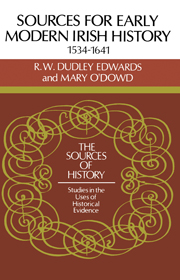Book contents
- Frontmatter
- Contents
- Acknowledgements
- Abbreviations
- Introduction
- 1 IRISH CIVIL CENTRAL ADMINISTRATION
- 2 IRISH CIVIL LOCAL ADMINISTRATION
- 3 ENGLISH AND OTHER CENTRAL ADMINISTRATIONS AND IRELAND
- 4 IRISH ECCLESIASTICAL ADMINISTRATION
- 5 CONTEMPORARY ACCOUNTS AND DESCRIPTIONS
- 6 MAPS AND DRAWINGS
- 7 ARCHIVAL COLLECTIONS
- 8 HISTORIOGRAPHY
- Index
6 - MAPS AND DRAWINGS
Published online by Cambridge University Press: 08 January 2010
- Frontmatter
- Contents
- Acknowledgements
- Abbreviations
- Introduction
- 1 IRISH CIVIL CENTRAL ADMINISTRATION
- 2 IRISH CIVIL LOCAL ADMINISTRATION
- 3 ENGLISH AND OTHER CENTRAL ADMINISTRATIONS AND IRELAND
- 4 IRISH ECCLESIASTICAL ADMINISTRATION
- 5 CONTEMPORARY ACCOUNTS AND DESCRIPTIONS
- 6 MAPS AND DRAWINGS
- 7 ARCHIVAL COLLECTIONS
- 8 HISTORIOGRAPHY
- Index
Summary
MAPS
The assumptions and axioms of contemporary commentators and observers changed drastically in early modern Ireland and notably between the mid sixteenth century and the mid seventeenth century. In no body of source material does this emerge so dramatically as in contemporary maps. Ireland, from being one of the perimeter areas represented by symbolic amorphous shapes, becomes involved in the western cosmographical revolution. Thanks to the necessities of defending the English monarch's realm from possible invasion, coastal maps of a new type emerge as strategic points are fortified and mapped. The administrative expansion following the defeat of the Geraldine rebellion is gradually recorded in terms of the necessities of coastal defence, of conquest, of colonisation and of administration. All this is carried out by a great variety of amateur mappers of varying quality, many of them improved through contacts with professional cartographers from Italy or the Low Countries. It is not always clear whether the maps were the works of soldiers, engineers, draughtsmen or even cartographers, the latter conceivably perfecting their products in studios remote from the scenes depicted. The presence of substantial numbers of documents coloured brightly is a reminder that the period was one in which painting was increasingly in vogue. Administrators and scholars with literary ambitions frequently employed maps in which they embodied questionable references to islands, sea monsters and other Irish mythological allusions, and often accompanied their references with substantial documentation. This suggests the need for alertness because modern repository policy detaches drawings from descriptions. It is necessary to bear in mind that to be adequately critical the student must consider the totality presented by an author to his patron.
- Type
- Chapter
- Information
- Sources for Modern Irish History 1534–1641 , pp. 106 - 128Publisher: Cambridge University PressPrint publication year: 1985



